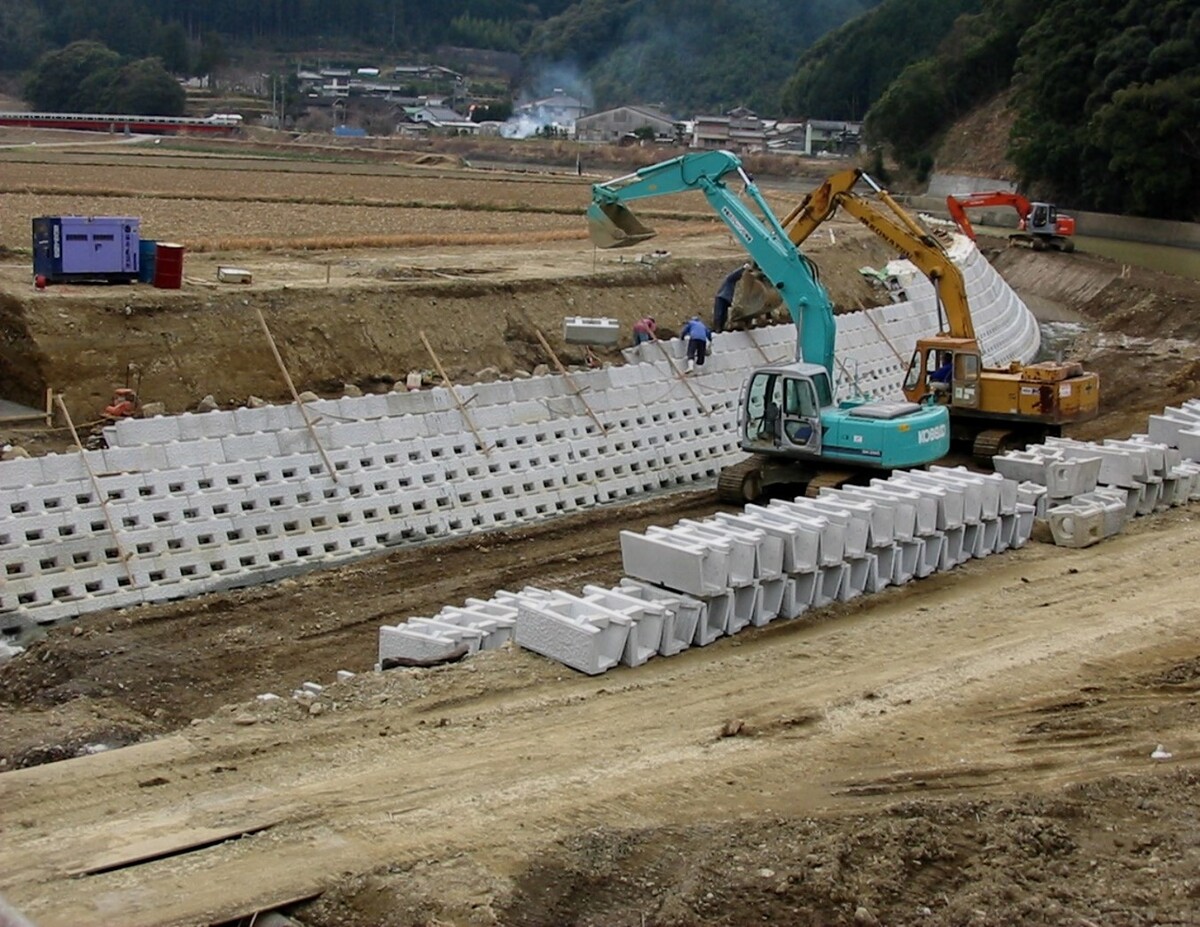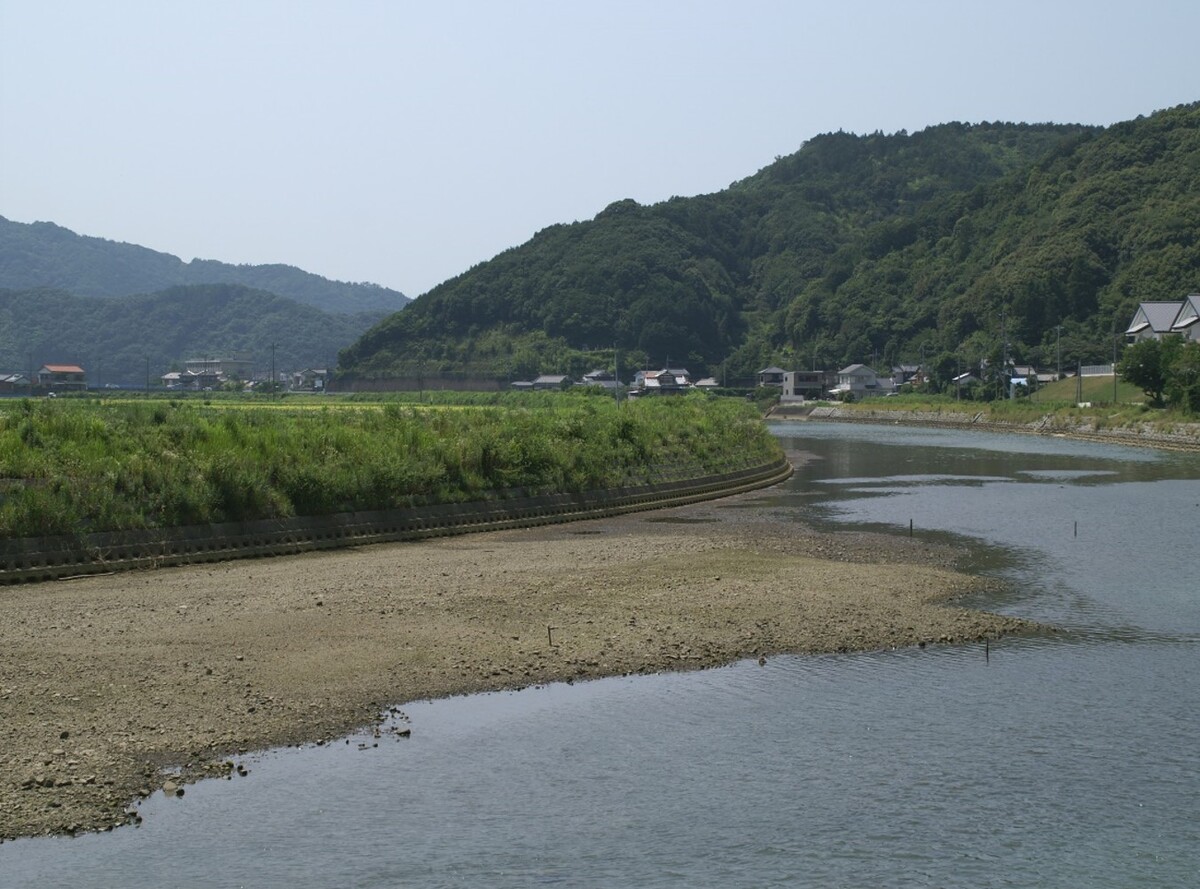
Top: Immediately after construction Bottom: 2 years after construction by SAIBARA IRONWORKS CO,. Ltd
Issue
Frequent flooding is a persistent challenge nationwide in Thailand. Floods like that in the Chao Phraya basin in 2011 are a continual challenge in Thailand, resulting from the annual rainy season and extreme weather events. There is a pressing need for flood control technology to withstand long-term, repeated flooding while maintaining the river ecosystem.
The existing iron and concrete methods for reinforcing riverbanks in the country have proven unsustainable, necessitating frequent repairs and reconstruction every few years. Successful integration of an initially foreign-made alternative needs continual cooperation and ensuring the solution will work in Thailand’s environment.
Solution
Japan has a strong history of implementing environmentally friendly revetment blocks, which cover 400,000 m2 in the country. This innovative solution may offer long-lasting flood control – reducing costs and improving livelihoods and agricultural infrastructure. A proposed Thailand–Japan collaboration emphasizes technology transfer that benefits both countries.
Overview
Thailand experiences severe flooding in urban and rural areas due to annual heavy rains, inadequate infrastructure, and the increase in extreme weather events. Poor-quality river embankment protection methods in the country have led to substantial damage and the need for recurring repairs.
The Japan International Cooperation Agency (JICA), Sukhothai Provincial Governor’s Office, and Japanese manufacturer Saibara Iron Works have been collaborating to implement shoreline technology designed to reduce flood impacts in Thailand. Through this collaboration, a survey was conducted to determine the feasibility and effectiveness of installing sustainably designed revetment blocks, which have been used for decades in Japan. The survey found the blocks are a viable solution to stabilize river and canal shorelines and lessen flood waters. The next stage of the project, revetment installation, is underway.
Details
Thailand experiences yearly flooding and landslides due to seasonal heavy rainfall and inadequate infrastructure. While the central government has taken steps through water resource management and reconstruction initiatives, a long-term and sustainable solution needs to be integrated into the nation’s public works systems.
Now, the Japan International Cooperation Agency (JICA), Sukhothai Provincial Governor’s Office, and Japanese company Saibara Iron Works are working together to mitigate flood-related natural disasters in Thailand’s Sukhothai Province with Saibara Iron Works’ environmentally friendly revetment blocks. Concrete revetment blocks are typically rectangular and designed to interlock. They’re placed along a sloping shoreline both above and below water.
A pilot project is underway for installing the blocks.

Under construction
by SAIBARA IRONWORKS CO,. Ltd

2 years and 4 months after construction
by SAIBARA IRONWORKS CO,. Ltd
Environmentally friendly revetment blocks: Sustainable alleviation flood damage
Saibara Iron Works’ innovative blocks are specially designed to reduce impact on the natural environment, protecting natural resources. The blocks, named Kankyo, have been successfully used in rivers and irrigation canals in Japan for over 20 years and now cover 400,000 square meters. Kankyo blocks excel at erosion control and embankment protection, effectively responding to shifting water levels. They also allow for vegetation growth at the surface and underwater, reinforcing strength and stability, and they maintain ecological balance while providing design flexibility to match the shape of a river’s curves and bottom.
The Sukhothai provincial public works has used iron plates and concrete walls for embankment reinforcement. Sites there have experienced repeated flooding, bringing the need for emergency measures after revetment damage and flood damage compensation (exceeding 300,000 Thai baht in 2021). The longevity and flood control of Kankyo blocks can eliminate frequent repairs and lessen flood damage, bringing substantial cost savings.
Preliminary survey results and prospects
JICA released a report detailing the first stage of the pilot project in Sukhothai. The project consists of three steps: developing a collaborative approach with local companies through a survey (2020–2022), installing the product (2023–2025), and public procurement for future implementation (2026). At the time of the JICA report, the first stage of developing a collaborative approach with local companies was complete and the second stage was in progress.
From the survey results obtained through the project's first stage, the three parties understood the needs of local stakeholders such as construction companies and government offices, identified vulnerable areas needing flood mitigation, and assessed collaboration opportunities with local companies. These entities evaluated the revetment blocks’ suitability for flood prevention and implementation by local construction companies and devised a business plan.
The business model proposes transferring the revetment block technology to local companies and promoting the blocks through the government for public adoption. Although the project was still in progress at the time of the JICA report, the expected impacts include overcoming flood vulnerability, preserving natural resources, maintaining existing infrastructure, and stimulating local economies.
Kankyo revetment blocks present a sustainable solution to Thailand’s persistent struggles with flooding. With a comprehensive business model, the proposed project can help build climate resilience. At the same time, public works departments can integrate and expand these methods nationwide to develop more robust flood management along rivers and canals.
*Read the full report here (PDF; English from page 43).




